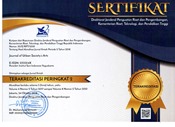Designing a Design Thinking Model in Interior Design Teaching and Learning
Abstract
In the last three decades, research on design processes and methods has been the driving force behind the design science development; however, research on design process knowledge has not developed much in Indonesia. This research aims to answer the problems faced by interior design students when they have to complete a design task by applying specific design processes and methods. The choice of technique and method is influenced by the situation & conditions in which the design is carried out. The research was carried out using the “double diamonds” process and method with a problem-solving approach. The research analysis was carried out by examining students’ design documents in the interior design course, conducting interviews with students and lecturers, and literature studies. Furthermore, an alternative process model and design method are more prepared to follow the needs and answer the Interior Design Study Program’s problems when completing a design task. Research has succeeded in finding process models and design methods called a DT-DI model compatible with interior design students.
Keywords
Full Text:
PDFReferences
Brown, T. (2008). Design Thinking, Harvard Bussines Review, June, hrb.org., diakses 13 April 2013.
Carmel-Gilfilen, C., & Portillo, M. (2010). Creating Mature Thinkers in Interior Design: Pathways of Intellectual Development. Jurnal of Interior Design, 35(3), 1 – 20.
Ching, F. D. (1987). Interior Design Illustrated. New York: Van Nostrand Rheinhold Inc.
Chon, H. H. (2019). “From design thinking to design knowing: an educational perspective.” LASALLE College of the Arts, Singapore, Art, Design & Communication in Higher Education, 18(2).
Council, D. (2004). Double Diamonds. London: UK.
Cross, N. (1982). Designerly Ways of Knowing. Design Studies, 3(4), 221–227.
Cross, N. (2006). Designerly Ways of Knowing. London: Springer.
Donar, A. (2011). Thinking Design and Pedagogy: An Examination of Five Canadian Post- Secondary Course in Design Thinking.
Doorst, K. (2019). Design Beyond Design. sheji The Journal of Design, Economics, and Innovation, 5(2).
Friedman, K. (2000). Design Education in the University: Professional Studies for the Knowledge Economy. in Procs of Re-inventing Design Education in the University. Perth.
Friedman, K. (2019). Design Education Today: Challenges, Opportunity, and Failures.
Garner, S. (2005). Revealing Design Complexity: Lessons from the Open University. CoDesign, 1(4), 267–276.
Jones, J. C. (1970). Design Methods. New York: John Wiley & Sons Inc.
Kelley, T., & Littman, J. (2002). The Art of Innovation. (Paulus Herlambang, Ed.). Jakarta: PT. Gramedia Utama.
Kilmer, R., & Kilmer, W. O. (2014). Designing Interior (2 ed.). New Jersey: John Wiley & Sons Inc.
Linberg, Noweski, C., & Meinel, C. (2010). Evolving Discourses on design thinking: how design conation inspires meta-disciplinary creative collaboration. Technoetic Arts, 8(1), 31–37.
Meyer, M. W., & Norman, D. (2020). Changing Design Education for the 21st Century. She Ji: The Journal of Design, Economics, and Innovation. https://doi.org/https://doi. org/10.1016/sheji.2019.12.002
Muratovski, G., & Butler, D. (2015). Paradigm Shift: Report on the New Role of Design in Business and Society. she ji The Journal of Design, Economic, and Innovation, 1(2).
Noweski, C., Scheer, A., Buttnerr, N., von Thienen, J., Erdmann, J., & Meinel, C. (2012). Towards a paradignm shift in education practice: Developing 21st century skills with design thinking. In Design Thinking research: Understanding Innovation.
Orthel, B. D. (2015). Implications of Design Thinking for Teaching, Learning, and Inquiry. Journal of Interior Design, 40(3), 1–20.
Patter, & Pastor. (2016). Innovation Methods Mapping. New York: Humantific Publishing.
Sanders, E. B. N. (2006). Design Research in 2006. Design Research Quaterly, 1, 3–8.
Shively, K., Stith, K. M., & Rubenstein, L. D. (2018). Measurring what matters: Assessing Creativity, Critical Thinking, and the Design Process. GIFTED CHILD TODAY, 41(3).
Triatmodjo, S. (2014). Metode Pembelajaran Desain Interior Berbasis Kelas Studio. Prosiding Seminar Kajian Audiens dan Pendidikan Seni: Pengalaman Resepsi atas Model Struktural, Kultural dan Strukturasi.
Watson, & Associates. (2019). What is Design Thinking, accessed on Wednesday 2 September 2020 at https://www.watsonassociates.nl/en/ design-thinking/.
DOI: https://doi.org/10.24821/jousa.v7i2.4499
Refbacks
- There are currently no refbacks.

This work is licensed under a Creative Commons Attribution 4.0 International License. ISSN 2355-2131 (print) | ISSN 2355-214X (online).







